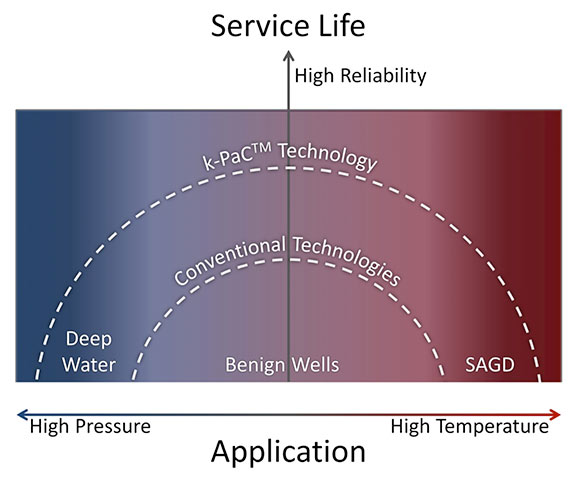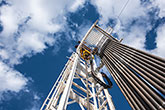Perfecting artificial lift
Roger Curtis Williams, ITT, USA, explains how new artificial lift technology offers increased lifetimes, productivity savings.
New technologies are enabling oil and gas production in more challenging environments than ever before. The high temperatures, extreme pressures and corrosive conditions of unconventional production wells have increased the strain on artificial lift technologies like electric submersible pumps (ESP) and all components of the ESP string.

Figure 1. Modern reservoir trends
Existing ESP string technologies are simply not designed to function under these kinds of harsh conditions and will often fatigue and fail more quickly than in more ‘benign’ wells, yet today’s market trends call for dramatically increased lifetimes for ESP technology – especially in extreme, unconventional environments.For example, modern steam-assisted gravity drainage (SAGD) applications require ESP string components to survive up to 500°F (260°C), an increase from conventional products of more than 100°. How is a technology with a two-year lifetime increased to five years while simultaneously exposing it to ever higher environmental stress factors?
Evolving ESP applications
ESP applications have broadened in recent years to apply to a variety of enhanced oil recovery (EOR) technologies. The two fastest trending EOR technologies are thermal recovery and CO2 injection. Thermal recovery, such as SAGD, stresses ESP components with extreme temperatures. CO2 gas can also damage ESP strings through rapid decompression, especially in environments like ultradeep offshore wells, where extreme pressure causes more gas to be absorbed by ESP string components.
Both SAGD and ultra-deep offshore drilling push the historical norms for pressure and temperature extremes. Figure 1 compares these high pressure/high temperature (HPHT) well conditions to conventional well conditions.
Whether reserves are locked 10 000 ft below the surface, experiencing pressures up to 25 000 psi at 300°F (149°C), or subjected to the extreme artificial temperatures and corrosive elements of a SAGD operation (500°F/260°C), more resilient, reliable downhole connectors are needed to sustain artificial lift technology.

Figure 2: The technology's pressure balance concept.
The challenges of ultradeep reservoirs
Conventional ESP cable feedthru systems that ensure safe passage of electricity through well safety barriers (like the wellhead, packers, etc.) in offshore wells were not designed for ultra-deep conditions in which production is becoming more prevalent. Most ESP cable connectors rely on elastomeric materials to seal out the surrounding pressure. These seals fatigue and deform, and are susceptible to failure by extrusion when exposed to pressure and temperature cycles in the well.
In addition, pumping the heavy bitumen in deep and ultra deepwater reservoirs requires a delicate control scheme to protect the pump, which includes regularly stopping and restarting the system. Some production companies cite thousands of such stop-and-start cycles throughout the life of one downhole ESP system. Every time this happens, all downhole equipment experiences decompression, and in wells with high gas content, these decompression cycles can tear apart elastomeric bodies due to absorbed gas expansion.
Adding to the challenges of these production environments, ESP cables must be spliced to reach the depths needed for deep and ultra-deepwater plays. This splicing balances the electrical phases, but introduces more components that can fail, potentially compromising the entire ESP string.

Figure 3: In situ connection (left) with electrical performance overlay.
Extreme temperatures in SAGD wells
Some SAGD operations will steam the production well with the ESP string installed, and turn the pump on intermittently to test whether the oil is hot enough to produce. This method reduces downtime and the steam loss experienced when installing the ESP string after steaming. While this practice saves both time and money, it exposes the ESP cable and penetrator systems to temperatures as high as 500°F (260°C), well above the range of conventional sealing technologies.
Corrosive and invasive gases
Some wells experience low-to-moderate pressures and temperatures, but pose a threat to downhole equipment due to corrosive or invasive gases. Hydrogen sulfide is notorious for corroding conductors after permeating through elastomeric barriers. Mobile gases such as CO2 may exacerbate the damage of rapid decompression, a particularly acute problem for elastomeric bodies.
Operational conditions have also become more complex. For example, improved downhole instrumentation has enabled remote operation of ESPs, often leading to more frequent pressure changes. These pressure cycles fatigue downhole equipment, diminishing cable and penetrator service life at a time when the demand for ESP string reliability has never been higher.
A new approach
To overcome these obstacles and meet changing expectations in the ESP market, ITT BIW Connector Systems set out to develop a new connector technology. The design goals for this technology included the following:
Keeping pressure in mind
The company’s pressure-balanced k-PaC Technology™ was developed for HPHT, corrosive gases, operator power cycling, and increased service life applications. The technology avoids the limitations of elastomeric seals by designing out the components that fatigue in challenging well conditions.
Connectors with this technology employ a pressure-balancing function that does not rely on elastomeric material to seal out well pressure. Rather, the pressure-balancing system works with the ambient pressure to create a resilient sealing mechanism. This mechanism accommodates stop-and-start cycles, and the improved temperature and pressure ratings extend the lifetimes of the connectors.
The technology eliminates typical elastomeric failure modes by design. A viscous dielectric medium (VDM) is contained between movable barriers built into the connector, enabling pressure balancing to the well conditions. Figure 2 illustrates this approach, the key benefits of this which include:
The technology has been incorporated into two different product categories that have undergone extensive in-house testing, requiring both new test equipment and a newly designed testing regimen. The technology has undergone field trials in SAGD applications with unprecedented results. Deep offshore field trials and sour gas testing are scheduled to begin in the third quarter of 2015.
The first qualified product using the technology was a high-temperature connector designed for SAGD wells, called the Metal-LokTM Ultra Wellhead Penetrator System. The application involves a cyclic steaming process with the ESP string installed, directly exposing the connector to 500 F°(260°C). Field trials for the SAGD connector commenced with Suncor Energy at Canada’s Firebag field in August 2014.
BIW Connector Systems’ Presta™ Deep Water Mechanical Splice is the second product to incorporate the technology. The splice was designed for deepwater offshore applications, and it is rated to 350°F (177°C) and 15 000 psi. The splice is more resistant to the effects of decompression from pump restarts, enabling it to meet the needs of deepwater reservoirs containing bitumen or other fluids that are notoriously difficult to pump.
Application-specific test regimes were incorporated to simulate deepwater offshore and SAGD wells. To ensure their validity, these tests were supplemented by external test houses and field trials.
Throughout the development of k-PaC Technology, the company continually upgraded test equipment to further measure the technology’s potential. An in situ monitoring capability was developed to observe electrical performance of the technology products during pressure cycling at rated temperatures.
Figure 3 shows the electrical feedthru on the environmental autoclave as well as an output plot demonstrating the electrical performance at temperature as the connector underwent pressure cycling. Insights gained from the in situ electrical data were crucial to the successful development of the technology connectors.

Figure 4: Application and reliability improvements offered by k-PaC Technology over other conventional technologies.
Testing and field trials
The development of the technology occurred in two main phases: prototyping and qualification, and field trials. During prototyping and qualification, the connectors were subjected to more than 1500 hours of grueling downhole environmental simulation in BIW Connector Systems’ HPHT autoclaves. Significant lab upgrades were required to stress and monitor the new technology.
Material qualification and system design required the use of the company’s 2192°F (1200°C) oven, 19 000 psi heated hydrostatic chamber, multimillion dollar material science laboratory, and most prominently, development of an in situ electrical monitoring capability outfitted to an autoclave capable of 7000 psi and 530°F(277°C).
BIW’s system with the k-PaC Technology was specifically developed for SAGD applications. Ongoing field trials of aspects of the technology are crucial for SAGD fields as they ensure improved steam resistance and increase temperature rating. At the Firebag field in Canada, where the technology is undergoing field trials, steam injection results in temperatures of 500°F(260°C). These wells use bullheading and the ESP string is routinely exposed to direct steam prior to production.
Overall, thermal stresses and pressure differentials can benefit from being managed through k-PaC Technology, resulting in lower fatigue effects and extended service life. Similarly, gas absorption is reduced by the VDM, enabling the connectors and pressure blocking penetrators to survive more pump restarts and decompression cycles than previously possible.
The technology’s elimination, by design, of common modes of failure also offers significant reliability improvements for connector technology in more traditional, benign wells. Figure 4 illustrates the limits of conventional technologies and shows the improvement k-PaC Technology offers, in terms of both harsh well applicability and overall reliability.
Reducing rig time, by design
Both products with the technology were designed for simple, reliable, and fast assembly. Functional tests were performed to measure the time needed for each product to be assembled. Assembly time for the 3-phase SAGD connector was less than 30 minutes.
Offshore, three mechanical splices with breakouts can be assembled in the field in less than 90 minutes and do not require the support of a highly trained splice technician. This is a major improvement over legacy technologies, and a cost saving for offshore rig projects whose costs can reach as much as US$1 million/d.
To demonstrate the cost savings of rig time, compare the mechanical splice assembly time to an industry average of four to eight hours needed to complete hand splice for deepwater offshore conditions. For a rig cost of US$300 000/d (US$12 500 per hour), the mechanical splice saves an average of US$31 333 per splice when compared to the fastest hand splice. The mechanical splice requires minimal training, enabling non-specialised personnel to complete the splice, and for multiple technicians to work together. No time is spent coordinating the arrival of a specialised hand-splicing technician, and no hours are wasted while the rig fee clock is ticking.
Conclusion
Evolving needs in the oil and gas industry have led to improvements in ESP technology. ITT BIW Connector Systems’ new technology was designed to meet the challenges of unconventional plays like deepwater offshore and SAGD applications. Benign wells also benefit from the use of the technology as product lifetime increases and reduced assembly times equate to smoother production cycles and reduced operating costs.
Read the article online at: https://www.oilfieldtechnology.com/product-news/16102015/perfecting-artificial-lift/
You might also like
tengizchevroil starts WPMP operations at tengiz oil field in Kazakhstan
Chevron has announced today that its 50 % owned affiliate Tengizchevroil LLP (TCO) has safely commenced operations at its wellhead pressure management project (WPMP) at the Tengiz oil field in Kazakhstan.

